The Legend of the Lion and the Sun
Reading time: 8 min
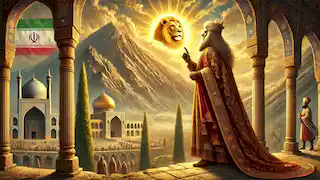
About this story: The Legend of the Lion and the Sun is a Legend from Iran set in the Ancient This Dramatic tale explores themes of Courage and is suitable for All Ages. It offers Moral insights. A tale of courage and unity from ancient Persia.
In ancient Persia, a vast empire stretching from the lush forests of the north to the golden deserts of the south, there existed a powerful symbol revered by the people—a lion and a sun. This symbol wasn’t merely an emblem; it held a deep, spiritual significance. It symbolized strength, courage, and an eternal light of wisdom that protected the empire and kept its people united. In every corner of the land, stories of the lion and the sun were passed down through generations, embedding themselves in the hearts and minds of the people. And, like all powerful symbols, it had its own legend—a tale that was both a celebration of Persia's ancient spirit and a reminder of its resilience.
Once upon a time, in a period far back in history, there was a kingdom ruled by King Jamshid, a wise and noble leader whose love for his people knew no bounds. His kingdom prospered, and peace reigned throughout the land. However, all knew that peace could be as fragile as the morning dew that melts under the midday sun. King Jamshid, though a strong ruler, often pondered the weight of his responsibility and sought a way to protect his kingdom even after his passing.
One evening, while gazing into the night sky, King Jamshid prayed to the heavens for a sign, something that would ensure Persia’s safety long after he was gone. As he drifted into a peaceful slumber, a vision appeared to him—a radiant sun resting on the shoulders of a mighty lion, shining brightly across his entire kingdom.
The dream was vivid, and King Jamshid woke with a sense of purpose. He called upon his most trusted advisor, the sage Astad, a man known for his wisdom and his ability to interpret dreams. Astad, upon hearing the king’s tale, nodded gravely. “My king,” he began, “the lion is a symbol of strength and power, while the sun represents enlightenment and wisdom. Together, they form a divine promise—a protection that cannot be broken as long as your kingdom remains true to these ideals.”
Enraptured by this vision, King Jamshid decided that the lion and the sun would become the sacred emblem of Persia. He had it crafted into his banners, his royal seal, and even the armor of his warriors. The lion, with the sun on its back, became a symbol that embodied courage, wisdom, and eternal guardianship.
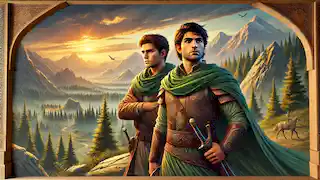
Many years passed, and the people of Persia came to revere the symbol of the lion and the sun. It was said to possess magical properties, protecting the land from invaders and guiding the people through times of strife. Stories arose around this symbol, each one more extraordinary than the last. One story told of a young warrior named Rostam, who, during a fierce battle, invoked the power of the lion and the sun to defeat an entire army with a single, mighty roar that echoed through the mountains.
Yet, no story was more famous than that of Mehr and Bahram. Mehr, a young prince from the northern mountains, and Bahram, a brilliant scholar from the southern deserts, were two friends bound by a destiny they did not yet understand. They had grown up hearing tales of the lion and the sun, each finding strength in the stories in different ways.
Mehr, strong and fearless, saw himself as a protector, believing it his duty to uphold the legacy of the lion. Bahram, on the other hand, was gentle yet wise, and he found comfort in the light of the sun, which he saw as a beacon of knowledge that would guide his people to prosperity. Together, they made a vow to honor the symbol of the lion and the sun and uphold its values in whatever way they could.
The kingdom of Persia flourished under this unity of strength and wisdom. But as history shows, prosperity often breeds envy. Rumors began to spread of a dark sorcerer from the distant west, a man known only as Kaveh, who sought to claim Persia for himself. Kaveh despised the symbol of the lion and the sun, for it was a symbol of unity and strength, and he thrived in division and fear. He was a master of illusion, skilled at conjuring shadows to deceive and manipulate.
As Kaveh approached the borders of Persia, he wove a powerful spell over the land. The sun began to dim, its light shrouded by an unnatural mist, and the lion, once fierce and proud, grew weaker, its mighty roars reduced to faint echoes. Fear gripped the hearts of the people as crops began to wither and rivers ran dry. It was as if the very spirit of Persia was fading.
In desperation, King Jamshid called upon Mehr and Bahram, urging them to seek out the heart of the lion and the light of the sun to restore their land. The two friends set out on a perilous journey, guided only by their faith in each other and the legend that had inspired them since childhood.
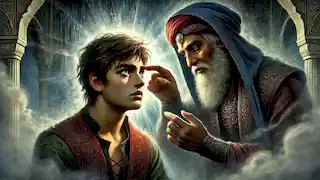
Their journey led them through dense forests, across towering mountains, and deep into the heart of the desert, where they faced trials that tested their courage and wisdom. At each step, they encountered visions meant to deter them—illusions cast by Kaveh to deceive them into abandoning their quest.
In one such illusion, Mehr saw a vision of his family suffering, trapped in an eternal storm with no end in sight. Distraught and confused, he nearly turned back. But Bahram, steady and wise, reminded him of the lion’s strength and the courage they had sworn to uphold. Together, they broke free of the illusion and continued their journey.
In another trial, Bahram was faced with a mirage of endless books, each filled with forbidden knowledge that promised him the answers to every mystery he had ever pondered. The temptation was great, but Mehr reminded him of the sun’s light and the responsibility that came with true wisdom. Together, they passed through the illusions, their bond growing stronger with each trial.
Finally, after many days and nights, they reached the summit of Mount Alborz, where the spirit of the lion and the sun was said to reside. There, in a secluded grove bathed in an otherworldly light, they encountered the ancient spirit that watched over Persia—a lion with a mane like fire and eyes that held the wisdom of countless generations.
The lion spoke, its voice a deep, resounding echo. “You have shown courage, young warriors, and you have upheld the values of strength and wisdom. But your journey is not yet over. To restore Persia, you must confront the darkness that has cast its shadow over the land.”
With renewed purpose, Mehr and Bahram descended from the mountain, determined to face Kaveh. They returned to the kingdom, where Kaveh’s influence had grown, casting fear and despair across the land. The people, once proud and resilient, had grown fearful, their faith in the lion and the sun shaken by the sorcerer’s magic.
In the heart of the kingdom, Mehr and Bahram confronted Kaveh. The sorcerer sneered at them, mocking their devotion to a “myth” he deemed powerless against his dark magic. But Mehr and Bahram stood firm, invoking the spirit of the lion and the sun. Together, they unleashed a powerful light that shattered Kaveh’s illusions, revealing the sorcerer’s true, twisted form.
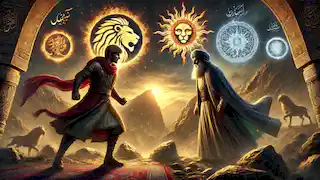
In the final battle, Mehr fought with the strength of the lion, his every movement embodying courage and power. Bahram, meanwhile, wielded the light of the sun, his mind sharp and clear as he guided their efforts with wisdom and strategy. Their unity, born of trust and shared purpose, proved to be Kaveh’s undoing.
As the dawn broke over the land, the lion and the sun rose once more, their light restoring the kingdom to its former glory. Rivers flowed again, crops began to grow, and the people’s faith in their ancient symbol was rekindled. Persia was saved, and the legend of the lion and the sun became even more revered than before.
In honor of Mehr and Bahram’s bravery, King Jamshid decreed that a monument be built—a grand statue of the lion and the sun that would stand as a testament to the courage and wisdom that had saved Persia. And so, the symbol of the lion and the sun lived on, a constant reminder of the power of unity, strength, and wisdom.
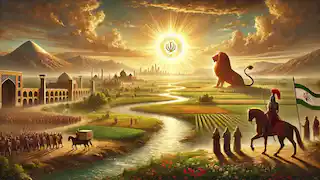
Generations passed, and the legend grew, intertwining itself with the very fabric of Persian identity. The lion and the sun became more than a symbol; they were the spirit of Persia itself, guiding the people through trials and triumphs alike. And as long as the people held true to the virtues of courage and wisdom, the lion and the sun would shine over Persia, guarding its people and inspiring them for all eternity.


















